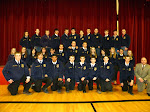At Stroller Vineyards, students learned about niche markets associated with viticulture, the food science and chemistry that are involved in making a quality product, as well as the intensive effort that goes into the marketing process. Strollers has made a tremendous investment in energy conservation, with such innovations as solar panels, recyclable construction and consumable materials, composting and using natural cooling principles and utilization of gravity flow for fluid movement. Andre Borlak learns the science of viticulture at Stoller’s Vineyard
Andre Borlak learns the science of viticulture at Stoller’s Vineyard
 Andre Borlak learns the science of viticulture at Stoller’s Vineyard
Andre Borlak learns the science of viticulture at Stoller’s VineyardStudents had the opportunity to experience the vastness of the marine portion of the Port Of Portland. The Port of Portland has an impact on 1 of every 14 jobs in the State of Oregon, and has an annual operating revenue of 168 million dollars. Students learned about the advances in port security and cargo x-rays. They watched the loading and unloading of containers on an oceanic cargo vessel and learned about how imports and exports affect our local economy. They were also introduced to the day-to-day operations of some of the Ports largest customers: Hanjin Shipping Lines, Toyota, Lufthansa, Columbia Sportswear, FedEx and Alaska Airlines. Perhaps the most remarkable thing about this tour was to learn about just how much of the common items we use on an everyday basis come through the Port of Portland in containers. Port of Portland
Port of Portland
 Port of Portland
Port of PortlandAt Vigor Marine and Portland Community College Shipyard and Welding Training Center, students observed construction of recently commissioned barges, Hanford’s 60,000 gallon stainless steel nuclear waste storage vessels and the repair work on ships in dry-dock, including the refitting of a top secret navy stealth ship.
Mike Rasmussen, PCC welding instructor and Vigor Marine Public Relations Representative stressed the point that even in these tough economic times, there are jobs in the metal industry. Vigor Marine recruits workers from all over the county because they cannot find enough skilled workers locally. When asked by one of the FFA students, what they need to do to get a job at Vigor Marine, Mr. Rasmussen responded, “It’s important to learn basic metal and welding skills in high school, but more importantly, show up to work on time everyday and be able to pass the monthly drug test. FFA members touring Vigor Marine Ship Yard. Left to right: Chad Waldron, Joe Carlon, Avery Overton, Andre Borlak, Daniel Miles
FFA members touring Vigor Marine Ship Yard. Left to right: Chad Waldron, Joe Carlon, Avery Overton, Andre Borlak, Daniel Miles
 FFA members touring Vigor Marine Ship Yard. Left to right: Chad Waldron, Joe Carlon, Avery Overton, Andre Borlak, Daniel Miles
FFA members touring Vigor Marine Ship Yard. Left to right: Chad Waldron, Joe Carlon, Avery Overton, Andre Borlak, Daniel MilesMonrovia is the largest container nursery in the world and offers a large range of intern opportunities. With over 600 hundred employees, on a typical summer day, they will ship 1.5 million dollars worth of foliage from their nursery. Our tour guides took us through the process of greenhouse and nursery management; controlling temperature, moisture, nutrients and plant pests, and the process of plant propagation and tissue culturing.
Willow Lake Water Reclamation Facility serves the entire Salem-Keizer area and processes over 155 million gallons of waste-water a day. The solid waste is extracted and shipped to Hermiston to be used as rangeland fertilizer. The liquid waste is then cleaned using natural biological agents and filtration techniques, and then chlorinated to kill any remaining pathogens. The reclamation plant than treats all the chlorinated water with ascorbic acid to neutralize it and render it harmless to aquatic life before dumping it into the Willamette River.
The focus and goal of the trip was to expose students to careers and jobs that they might not be familiar with, and to demonstrate how the concepts and principles that Agriculture teachers teach everyday in class, can be applied in real world work conditions.
All the tour guides and managers we spoke with stressed that even in times of economic slowdown, there is still a demand for high-paid skilled workers who are willing to work and willing to learn.
When asked what impressions they came away with from the tour, Daniel Stirwalt from Culver FFA said, “It’s amazing that they assemble the ships upside down and then flip them over.” He was also impressed with the post Panamaz cranes they use at the Port of Portland to load containers on the large ships that are too big to fit through the Panama Canal.”







